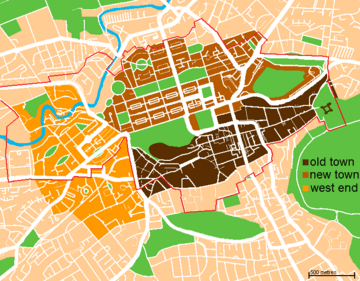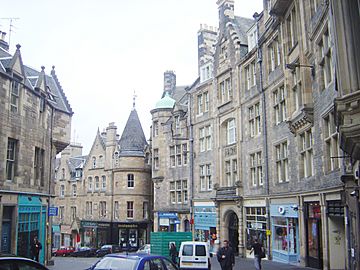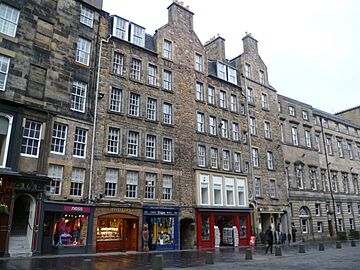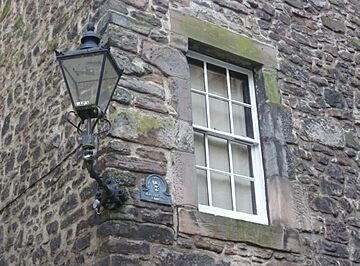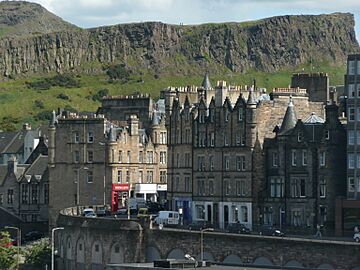Old Town, Edinburgh facts for kids
| UNESCO World Heritage Site | |
|---|---|

The Old Town seen from Princes Street
|
|
| Location | Edinburgh, Scotland, United Kingdom |
| Part of | Old and New Towns of Edinburgh |
| Criteria | Cultural: (ii)(iv) |
| Inscription | 1995 (19th Session) |
The Old Town (also known as Auld Toun in Scots) is the oldest part of Edinburgh, the capital city of Scotland. This historic area has kept most of its original street plan from the Middle Ages. Many buildings from the time of the Scottish Reformation (a big change in religion) are still standing. The Old Town, along with the newer 18th and 19th-century New Town and West End, is a special place. It is protected as a UNESCO World Heritage Site because of its unique history and buildings.
Contents
Exploring Edinburgh's Royal Mile
The "Royal Mile" is a popular name for the main street in Edinburgh's Old Town. This name was first used in the early 1900s. The street gently slopes downhill from Edinburgh Castle at one end to Holyrood Palace and the old Holyrood Abbey at the other.
Along the Royal Mile, you'll find many narrow alleyways called closes. These closes are often only a few feet wide. They lead steeply downhill from the main street to both the north and south.
Some important buildings in the Old Town include St. Giles' Cathedral, which is a famous church. There's also the National Museum of Scotland, full of interesting exhibits. The Old College is part of the University of Edinburgh. You can also see Parliament House and the modern Scottish Parliament Building. This area even has secret underground vaults and passages. These hidden spots are leftovers from older buildings.
It's interesting to know that no part of the street is officially called "The Royal Mile" for addresses. The actual street names, going from west to east, are Castlehill, Lawnmarket, High Street, Canongate, and Abbey Strand.
How the Old Town Was Built
The way the streets are laid out in Edinburgh's Old Town is like many old cities in northern Europe. But in Edinburgh, it's extra special. The castle sits on top of a rocky crag, which is what's left of an extinct volcano. The main street then runs down the top of a ridge from the castle.
This unique landform is called "crag and tail". It was made during the last ice age. Huge glaciers moved across the land, pushing away soft soil. But they split around harder volcanic rock, creating the crag and the tail. The hilltop crag was the first part of the city to grow. It became a strong fort, which is now Edinburgh Castle. The rest of the city slowly grew down the tail of land from the Castle Rock.
This spot was easy to defend. There was marshland to the south and a man-made loch (lake), the Nor Loch, to the north. People could only get into the town through gates in the city walls. Only small parts of these walls are left today.
The Royal Mile was originally a strong, straight main road. Only narrow closes and wynds (another word for alleyways) branched off its sides. From the late 1700s, wider new roads were added. These included the North Bridge and South Bridge. Later, George IV Bridge was built.
In the mid-1800s, more winding roads were added. One example is Cockburn Street, built in 1856. This street made it much easier to get from the Royal Mile to the new Waverley Station.
The Edinburgh City Improvement Act of 1866 brought even more changes. This plan was made by architects David Cousin and John Lessels. It had big effects on the city:
- St Mary's Wynd was taken down and replaced by the wider St Mary's Street with new buildings.
- Leith Wynd was removed. Jeffrey Street started nearby and curved west to join Market Street.
- East Market Street was built to connect Market Street and New Street.
- Blackfriars Street was made wider by removing buildings on one side.
- Chambers Street was created. It replaced older streets and squares. It was named after Sir William Chambers, who was the Lord Provost (like a mayor) of Edinburgh at the time. His statue is in the middle of the street.
- Guthrie Street was built to link the new Chambers Street to the Cowgate.
Areas of the Old Town

Besides the Royal Mile, the Old Town has several other areas. These include, from west to east:
- West Port: This was the old road leading out of Edinburgh to the west.
- Grassmarket: This area is located to the south-west of the castle.
- Edinburgh Castle: The famous castle at the top of the Royal Mile.
- The Cowgate: This is the lower southern part of the town.
- Canongate: This name correctly refers to the entire eastern district.
- Holyrood: This area contains Holyrood Palace and Holyrood Abbey.
- Croft-An-Righ: A group of buildings located north-east of Holyrood.
Tall Buildings in the Old Town
Because there wasn't much space on the narrow "tail" of land, and because it was safer to live inside the city walls, the Old Town became home to some of the world's first "high-rise" buildings. People started building multi-storey homes from the 1500s onwards.
Many of these buildings were destroyed in the Great Fire of Edinburgh in 1824. When they were rebuilt on the old foundations, the ground level changed. This created many passages and vaults (underground rooms) beneath the Old Town. New streets like North Bridge and South Bridge were built in the 1700s. These also created underground spaces, such as the Edinburgh Vaults under the South Bridge.
Historically, buildings were less crowded in the eastern part, called Canongate. In the 1950s, this area had a big cleanup and rebuilding project. Many old, crowded homes were replaced with new Council housing (public housing). From 1990 to 2010, many new housing projects were built throughout the Canongate. These new buildings are much taller than the older ones. They have greatly increased the number of people living in the area.
Discovering the Past: Archaeology
Archaeological digs are often needed before new buildings can be constructed in the Old Town. This work helps us learn a lot about the Old Town's past. Here are some things archaeologists have found:
- In 2012, experts found parts of a 16th-century building in Advocates Close. They also found very old remains from the 12th and 13th centuries. These older finds are rare because later building often removed them. The items found showed how the area grew in the 1500s and 1600s. They also showed how it declined later on.
- In 2008, archaeologists found signs of medieval land plots between the High Street and Jeffrey Street. They also found evidence of the multi-storey buildings from the 1500s. Later, a tannery (a place where animal hides are made into leather) was built there in the 1830s.
- In 1999 and 2000, parts of the medieval boundary ditch (a defensive trench) were found under St Mary's Street. Other parts of this ditch were also found in the Canongate and Cowgate areas.
- Digs for the new Scottish Parliament building showed over a thousand years of changes to the southern part of the Old Town.
- Excavations at Queensberry House found clues that Charles Maitland, a lord, might have used the kitchen of Queensberry House as a secret workshop. He might have been illegally taking money from the Royal mint.
- Since the 1980s, various digs have helped us understand St Giles' Cathedral and the City Walls better.
- Archaeological work from the 1970s to the 2000s has taught us about the buildings that stood before the Tron Kirk church.
Important Events in the Old Town
In 1824, a huge fire, known as the Great Fire of Edinburgh, destroyed most of the buildings on the south side of the High Street. This was between St. Giles Cathedral and the Tron Kirk.
During the Edinburgh International Festival, the High Street and Hunter Square become busy places. Performers from the Fringe advertise their shows here. They often do street performances to attract an audience.
On December 7, 2002, the Cowgate fire destroyed a small but dense group of old buildings. This fire was in the Cowgate and South Bridge area. It destroyed the famous comedy club, The Gilded Balloon. It also damaged a large part of the Informatics Department at the University of Edinburgh. This included their huge artificial intelligence library. The area was rebuilt between 2013 and 2014 with a new building, mostly used as a hotel.
New Developments in the Old Town
An area just north of the Canongate has seen a big redevelopment project. It was first called Caltongate, but now it's known as New Waverley. This project involved building new homes, hotels, shops, and offices. It was built on the site of an old bus depot. The project also developed the arches under Jeffrey Street and created a walking path from the Royal Mile to Calton Hill.
Some people, like author Alexander McCall Smith, were worried about these plans. They felt the modern design didn't fit with the Old Town's older buildings. They also thought it was not right for a UNESCO World Heritage site. Groups like the Cockburn Association and the Architectural Heritage Society of Scotland also opposed the Caltongate development. However, the developers said the completed project would be a "vibrant, exciting" place. The City of Edinburgh Council approved the plans in January 2014. Construction took place in the late 2010s.
|
See also
 In Spanish: Casco antiguo de Edimburgo para niños
In Spanish: Casco antiguo de Edimburgo para niños


